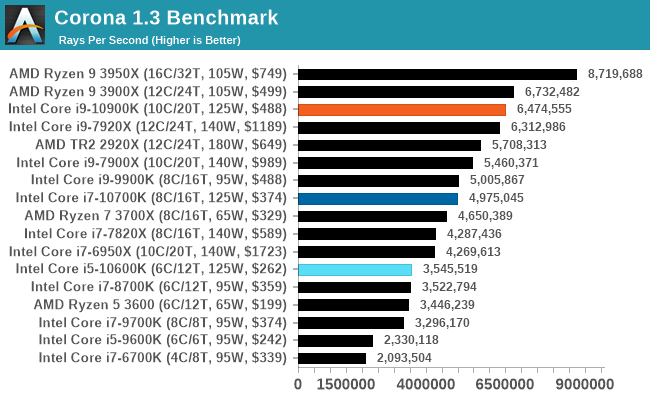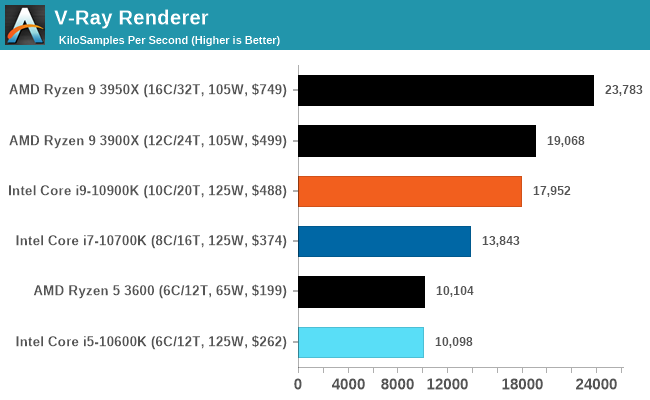The Intel Comet Lake Core i9-10900K, i7-10700K, i5-10600K CPU Review: Skylake We Go Again
by Dr. Ian Cutress on May 20, 2020 9:00 AM EST- Posted in
- CPUs
- Intel
- Skylake
- 14nm
- Z490
- 10th Gen Core
- Comet Lake
CPU Performance: Rendering Tests
Rendering is often a key target for processor workloads, lending itself to a professional environment. It comes in different formats as well, from 3D rendering through rasterization, such as games, or by ray tracing, and invokes the ability of the software to manage meshes, textures, collisions, aliasing, physics (in animations), and discarding unnecessary work. Most renderers offer CPU code paths, while a few use GPUs and select environments use FPGAs or dedicated ASICs. For big studios however, CPUs are still the hardware of choice.
All of our benchmark results can also be found in our benchmark engine, Bench.
Crysis CPU Render
One of the most oft used memes in computer gaming is ‘Can It Run Crysis?’. The original 2007 game, built in the Crytek engine by Crytek, was heralded as a computationally complex title for the hardware at the time and several years after, suggesting that a user needed graphics hardware from the future in order to run it. Fast forward over a decade, and the game runs fairly easily on modern GPUs, but we can also apply the same concept to pure CPU rendering – can the CPU render Crysis? Since 64 core processors entered the market, one can dream. We built a benchmark to see whether the hardware can.
For this test, we’re running Crysis’ own GPU benchmark, but in CPU render mode. This is a 2000 frame test, which we run over a series of resolutions from 800x600 up to 1920x1080. For simplicity, we provide the 1080p test here.
This is one of our new benchmarks, so we are slowly building up the database as we start regression testing older processors.

The Core i9-10900K scores 15 FPS at 800x600, which is just about playable.
Corona 1.3: Performance Render
An advanced performance based renderer for software such as 3ds Max and Cinema 4D, the Corona benchmark renders a generated scene as a standard under its 1.3 software version. Normally the GUI implementation of the benchmark shows the scene being built, and allows the user to upload the result as a ‘time to complete’.
We got in contact with the developer who gave us a command line version of the benchmark that does a direct output of results. Rather than reporting time, we report the average number of rays per second across six runs, as the performance scaling of a result per unit time is typically visually easier to understand.
The Corona benchmark website can be found at https://corona-renderer.com/benchmark

Blender 2.79b: 3D Creation Suite
A high profile rendering tool, Blender is open-source allowing for massive amounts of configurability, and is used by a number of high-profile animation studios worldwide. The organization recently released a Blender benchmark package, a couple of weeks after we had narrowed our Blender test for our new suite, however their test can take over an hour. For our results, we run one of the sub-tests in that suite through the command line - a standard ‘bmw27’ scene in CPU only mode, and measure the time to complete the render.
Blender can be downloaded at https://www.blender.org/download/

V-Ray
We have a couple of renderers and ray tracers in our suite already, however V-Ray’s benchmark came through for a requested benchmark enough for us to roll it into our suite. We run the standard standalone benchmark application, but in an automated fashion to pull out the result in the form of kilosamples/second. We run the test six times and take an average of the valid results.
This is another one of our recently added tests.

POV-Ray 3.7.1: Ray Tracing
The Persistence of Vision ray tracing engine is another well-known benchmarking tool, which was in a state of relative hibernation until AMD released its Zen processors, to which suddenly both Intel and AMD were submitting code to the main branch of the open source project. For our test, we use the built-in benchmark for all-cores, called from the command line.
POV-Ray can be downloaded from http://www.povray.org/

Interestingly the Core i9 with only 10C outperforms the 12C Ryzen 9 3900X here, likely due to the higher sustained frequency of the Intel chip. We clocked 220W on our Intel chip for this test however, well beyond the 120W of the AMD processor.












220 Comments
View All Comments
Boshum - Wednesday, May 20, 2020 - link
I generally agree, but I'm not so certain AMD will be in 2nd place within 5 years (from a best CPU architecture point of view). They should be considering the difference in resources, but Intel is so spread out and AMD seems so focused.poohbear - Wednesday, May 20, 2020 - link
OK i'll bite. Why would anyone buy this generation of Intel processors when AMD's is just as powerful and yet more efficient being on 7nm? Especially with Ryzen 4000 coming out this fall.dguy6789 - Wednesday, May 20, 2020 - link
AMD is ahead in a few key areas- price vs performance, total number of cores/threads, power.Intel is still ahead in the per core/per thread area. An Intel 8 core 16 thread will beat an AMD 8 core 16 thread in absolutely everything because of just how high Intel chips can clock to. In short, Intel is a higher performing albeit more expensive option for low thread count workloads.
Boshum - Wednesday, May 20, 2020 - link
I don't think the power and heat are too big a deal until you hit the 8 and 10-core K chips. The people that buy those are enthusiast gamers who want the highest possible FPS in games (whether they are able to perceive it or not, but I am sure they can in certain scenarios). A lot of those ultra-enthusiasts have a lot of fun with overclocking too, and Intel gets more out of that.Ryzen 4000 will undoubtedly be a better overall chip, but Rocket Lake should be coming to the LGA 1200 platform in the not too distant future. It may pass up Ryzen 4000 in gaming for those benchmark enthusiasts. It will be no match for Ryzen 4000 in heavy multi-core scenarios.
gagegfg - Wednesday, May 20, 2020 - link
At the end of the day, AMD continues to have the performance crown at a price premium (3950X).Also, it seems to me a bad ANANTECH policy for many graphics that do not have an AMD equivalent CPU and only put the 3600.
mandoman - Wednesday, May 20, 2020 - link
I can't imaging anyone being the slightest bit concerned about power on the HEDT! It's simply ludicrous to even bring it into the discussion. Frankly the whole emphasis in this review smacks loudly of "tree hugger" philosophy which has no place in the high end computing arena at all.Beany2013 - Wednesday, May 20, 2020 - link
Some of us actually care about good engineering rather than pushing an old, inefficient process node as hard as technically possible.Enjoy dropping an extra £100 just to cool your CPU.
Hxx - Wednesday, May 20, 2020 - link
WHAAT? U think this is not good engineering? this is BALLS engineering, they basically achieved a miracle on the 14nm platform. You are basically standing in front of a miracle. Step back and think about it. A 5 yo technology that competes and beats in many tests the competitor's 7nm process. Yes overall AMD may be the better purchase but again that not what im saying.Just think about that. On top of that they added good overclocking, controlled temps, plenty features, etc . Cant say im impressed with the Z490 platform itself since its the same old z390/70/270/170 with better connectivity but the CPU themselves will make history I mean the 14nm process sure is effing OLD but man what these guys did with this, the refinement it went through to achieve this performance on this OLD tech is amazing in my opinion and for that I applaud them. I want them to hurry up and wrap up Rocket Lake but this is definitely for sure no doubt definitely great engineering.
alufan - Thursday, May 21, 2020 - link
so what exactly do you think would happen if AMD did the same thing threw the power limits out the window and used a 14++++++ node with the extra thermal headroom available with the 3000 series chips, Intel has not released its new process node chips because they cant make them work AMD has and the limitations are simply due to the node size and physics, they have engineered a way round the issue Intel even now is talking about backporting designs it stinks, this is a "new" chip from Intel with more top end period AMD has released 3 nodes in 3 years and has a new version coming up in a few months with a rumored 20% uplift in IPC but lets wait and see, not to mention 5nm is designed and being sampled and 3nm is in design, that is EngineeringHxx - Thursday, May 21, 2020 - link
ROFL AMD? AMD struggles with getting a BIOS right let alone fine tuning a platform ? Nah they are too busy now supposedly giving us a beta bios for the 4xx series and that's a very scary thought given AMD's track record. In case you didn't know, AMD doesn't make their own chips. If tsmc moves to a different node then so will AMD, that's how it works. So yes I applaud TSMC for good engineering, AMD not so much.